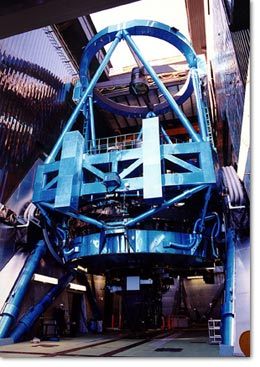Colour composite image of the Subaru XMM-Newton deep survey field. In the right panel, the red galaxy at the centre of the image is the most distant galaxy, SXDF-NB1006-2, according to the astronomers. Image by NAOJ
Japanese astronomers who have been using the Subaru and Keck optical/infrared telescopes on Hawaii’s Mauna Kea are claiming they have discovered the most distant galaxy ever, at a distance of 12.91bn light years away from planet Earth.
Hawaii’s Mauna Kea 4,200 metre-high summit itself hosts the world’s largest observatory for optical, infrared and submillimeter astronomy.
Just last week, for instance, NASA broadcast a live webinar of the transit of Venus based on obervations of the astronomical event from Mauna Kea.
Up to now, the latest consensus had been that the universe began 13.7bn years ago with the big bang. A light year stands for the distance that light travels in a year.
The scientists’ findings will be published in the Astrophysical Journal on 20 June. They claim to have found SXDF-NB1006-2, which they said is slightly farther away than GN-108036. The Subaru telescope discovered this particular galaxy last year and it was the most distant galaxy discovered at the time.
The team of Japanese astronomers has been led by Takatoshi Shibuya from the Graduate University for Advanced Studies in Japan and also involved Dr Nobunari Kashikawa from the National Astronomical Observatory of Japan (NAOJ), Dr Kazuaki Ota from Kyoto University and Dr Masanori Iye from the NAOJ.

The Subaru telescope on Mauna Kea. The telescope itself weighs 25.1 tonnes. Image by NAOJ
Cosmic dawn and the early universe
The astronomers are also claiming their research has verified that the proportion of neutral hydrogen gas in the 750m-year-old early universe was higher than it is today.
“These findings help us to understand the nature of the early universe during the ‘cosmic dawn’, when the light of ancient celestial objects and structures appeared from obscurity,” indicated an NAOJ statement.
The Japanese astronomers have touched on how, about 200m to 500m years after the big bang, the dense parts of neutral hydrogen clouds contracted under their own gravity, forming the first stars and galaxies.
“The radiation from this first generation of stars started to heat and reionise the hydrogen in nearby space, eventually leading to the reionisation of the entire universe. This was the era of ‘cosmic reionisation’,” said the NAOJ.